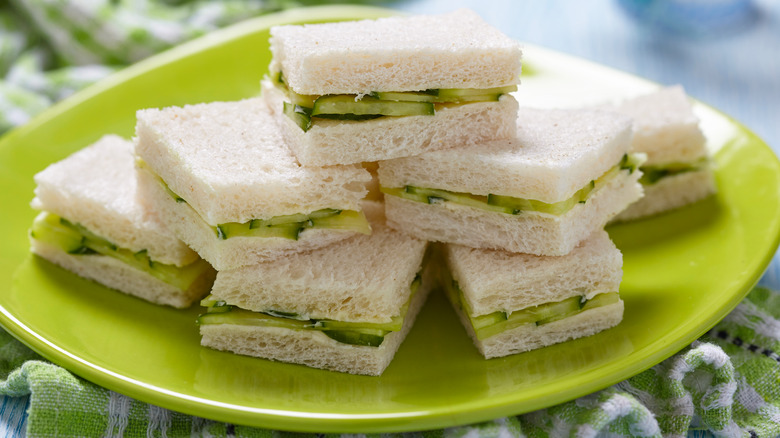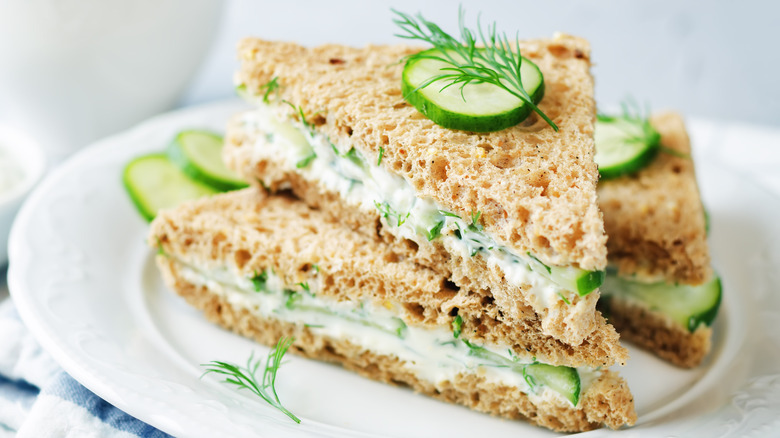What Makes Traditional Cucumber Sandwiches Special?
There are few sandwiches more dainty or posh than the traditional cucumber sandwich. In contrast to the typical stacked, saucy, or melty sandwich combinations Americans typically enjoy, these crust-less finger sandwiches have few ingredients and are known for being a light and refreshing eat. If you watch British historical dramas, you've no doubt seen them being enjoyed at tea time, especially by society's elite. Perhaps you've heard references to them so often that you've even tried making them at home.
The cucumber sandwich, also known as the tea sandwich, has been the ultimate English afternoon high tea staple for over a century. Its texture combines pillowy soft bread with the subtle crunch of cucumbers along with various herbs and creamy spreads, depending on what recipe variation you're snacking on. Some prefer to stick to eating delicate cucumber sandwiches that are free of embellishments, but over time, it's become popular to layer them with a thicker, more flavorful dressing for a bit more oomph.
Cucumber sandwiches appeared during the Victorian era
These fancy sandwiches date back to 19th-century India – the country where cucumbers originated. When British army officers sought sanctuary in tea houses to avoid the sweltering heat, they were served cucumber sandwiches, which kept them hydrated and cool due to the veggie's high water content. It was during this Victorian era that Britain turned cucumber sandwiches into a popular miniature meal eaten by members of the upper class. According to The Telegraph, the "lower classes preferred not to waste energy on something with so little protein."
For a while, cucumber sandwiches were eaten as this sort of pure indulgence with a piping hot cup of tea. They are mentioned several times in Oscar Wilde's play, "The Importance of Being Earnest", labeled by the protagonist as a "reckless extravagance" when his brother can't stop stuffing his face with them.
As the rest of the world got word of these indulgent little morsels, several variations cropped up that can include eggs, tuna, cream cheese, or a freshly made Benedictine spread.
Traditional ingredients and other common variations
With how delightfully simple these bite-sized sandwiches are, it can be hard to eat just a few when faced with a carefully curated platter. Though preparing cucumber sandwiches can be somewhat tedious, they're not hard to make from scratch, especially if you have access to English cucumbers instead of the typical American variety. Compared to western cucumbers, which are short, thick, and filled with seeds, English cucumbers are long, seedless, and have thin skin. For these reasons, it's clear why they're the ideal choice. If you can't find English cucumbers, you'll have to take the extra steps of removing the skin and seeds of its American counterpart.
Traditional English recipes feature triangularly cut pieces of buttered white bread stacked with thinly sliced fresh cucumbers, zested with a dash of salt and lemon juice. But if you want more flavor, you can whip up any number of sauces or spreads to put on your bread: Benedictine, homemade tzatziki sauce, cream cheese, or a blend of mayo, mustard, and chives. Using a mandoline will achieve the best results when slicing cucumbers or you can simply use a sharpened knife to slice them paper-thin. Once the cucumber sandwich is layered with all the ingredients, including salt, pepper, dill, or lemon juice, each piece is smushed together, the crust is removed, and the sandwiches are served as dainty quartered triangles.


